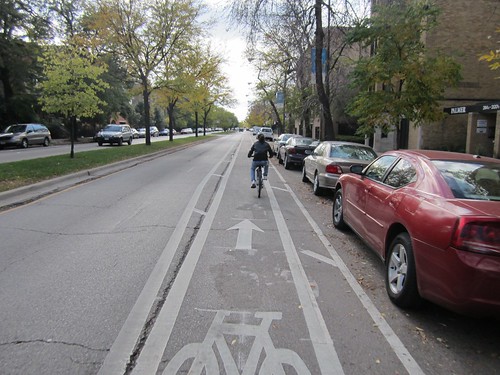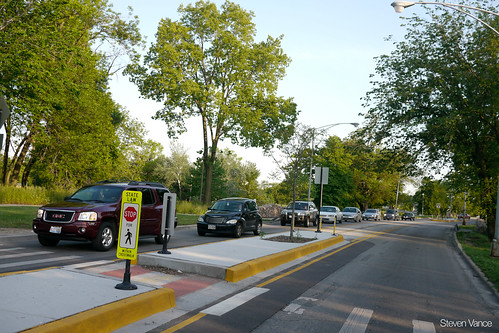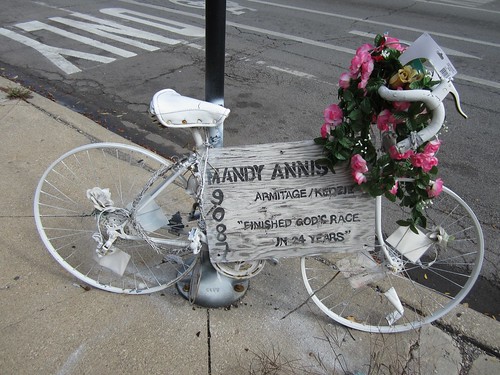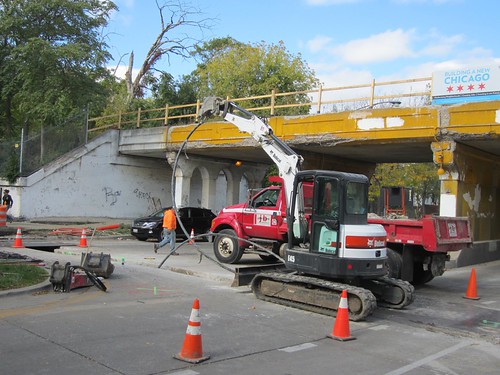Here at Streetsblog, we’re not shy about pointing out when we feel a local politician is on the wrong side of a transportation issue, but we're also happy to spread the word when an alderman changes his or her stance and becomes friendlier to biking, walking, and/or transit.
That seems to be the case with 26th Ward Alderman Roberto Maldonado. In 2010, the Chicago Department of Transportation implemented a road diet on Humboldt Boulevard through the eponymous park. New pedestrian refuge islands made it easier to cross the street on foot, and the removal of travel lanes calmed traffic, but the alderman requested that cyclists not be accommodated with bike lanes.
The resulting configuration has pinch points that make it unsafe for drivers and cyclists to share the remaining travel lanes. After the street was reconfigured, CDOT took Humboldt Boulevard off the 2011 edition of the city’s bicycle map as a recommended route, making this the only segment of the Boulevard System that wasn't designated as bike-friendly. The stretch was reinstated as a recommended route on this year’s map, but it probably shouldn’t have been, because it really doesn't feel safe to ride there.
It was good to hear that Maldonato has apparently changed his attitude towards biking. For a few years Kedzie Avenue, two blocks west of Humboldt, has had conventional bike lanes between North Avenue and Palmer Street, but they dropped out between Moffat Street and Armitage Street to make room for four lanes of car traffic with sharrows. “That was done a few years back when maintaining auto capacity was the norm,” CDOT Project Manager Mike Amsden told me in August. “We had a request from Alderman Maldonado to make it better for bikes. He didn’t like the fact that you had a bike lane that disappeared.” As a result, Amsden said, the whole segment of Kedzie would be converted to two travel lanes with buffered bike lanes.
While the new .75-mile bikeway doesn’t include physical protection for cyclists in the form of parked cars or flexible posts, the road diet and bike lane upgrade from conventional to buffered lanes makes the street more pleasant to bike on. Notably, it’s the only buffered lane in Logan Square, one of the top Chicago neighborhoods for bike mode share, which also has zero protected lanes.
When I took a spin on Kedzie early this afternoon, car traffic was flowing in a smooth and orderly fashion within the single travel lanes in each direction, and I didn’t notice any speeding or people driving in the bike lanes, although I saw a couple of double-parked cars. The bike lanes are striped through the intersections as dashed lines, and the pavement quality is generally okay, although there are a few locations where deep crevasses in the asphalt pose a bit of a hazard.
At Armitage, the bikeway reverts to bike lanes with no buffer in order to make room for right- and left-turn lanes. Here there’s a ghost bike memorial to Mandy Annis, a schoolteacher who was killed on her bike at age 24 by a motorist who blew a red light in the spring of 2008. Six months earlier, Blanca Ocasio, a 19-year-old pharmacy student, was fatally struck while biking at the same intersection, by a right-turning garbage truck driver. A ghost bike honoring Ocasio also stood here for several years but was recently removed.
At Bloomingdale Avenue I encountered a crew laying conduit as part of the Bloomingdale Trail project. “It’s for fiber optic cable,” one of the workmen told me. “The trail will have fiber optic, electrical, cameras, all that s---.”
While the north end of the Kedzie bike lanes connect with existing bike lanes on Palmer, south of North Avenue there are no bikeway markings on Kedzie. In the future, it would be great to see the Kedzie lanes extended north to meet up with the popular Milwaukee Avenue route, and continued south to connect with existing protected lanes on Franklin Boulevard.
Ideally, the northern extension would involve converting two of the four central travel lanes on Kedzie Boulevard between Palmer and Milwaukee to protected lanes, which would discourage speeding and shorten crossing distances for pedestrians. Currently, crossing this broad, high-speed section on foot at non-signalized intersections feels like a game of Frogger.









